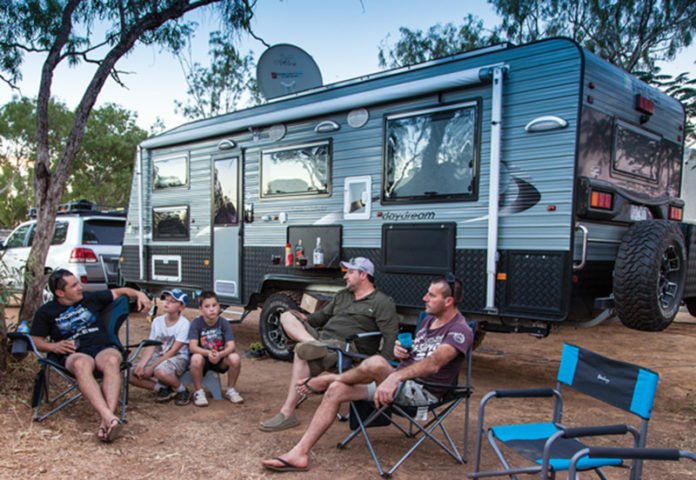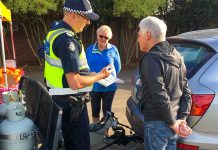Caravan payload. There’s no getting around this crucial aspect of caravanning. Everything you load into your van, from the water in the tanks to the flour in the cupboard, will erode the payload allowance of your caravan, motorhome or camper trailer.
How do you calculate the payload allowance? Fortunately, this is the easy part. Simply subtract the Tare weight (the unladen weight of the van, as it left the factory, minus any dealer-added features) from the van’s Aggregate Trailer Mass. Whatever the difference is in kilograms is the amount of combined weight you can allow for everything you put into the van.
Simple, right? Not so fast. While calculating payload requires only a little grey matter, getting it wrong can have serious consequences. Let’s deal with them first.
LEGAL LOADING
If you overload your van, you’re not only putting the stability of your van at risk, you’re jeopardising the safety of yourself and other road users. In the event of an accident, if you’re found to have done the wrong thing it’s not likely the warranty of your vehicle and van will be honoured, and I can’t imagine your insurance company sticking with you. The legal consequences could be worse still.
With all of this is in mind, I decided on an experiment: individually weigh the objects we have permanently packed in our family van, along with enough provisions for a couple of days of vanning. The results were very instructive. Who would’ve thought, for example, that a simple camp chair weighs almost 5kg?
 My wife and I have three kids, 9, 5, and 2, which means we need to pack fairly generously for long trips; for short trips, however, we try to keep things light. Our van’s Tare weight is 1525kg, while the ATM is 2000kg. This gives us a payload capacity of 475kg – reasonably generous for a single-axle rig.
My wife and I have three kids, 9, 5, and 2, which means we need to pack fairly generously for long trips; for short trips, however, we try to keep things light. Our van’s Tare weight is 1525kg, while the ATM is 2000kg. This gives us a payload capacity of 475kg – reasonably generous for a single-axle rig.
The van has two water tanks, with a combined capacity of 120L, and two 9kg gas cylinders. For the purpose of this exercise, I have assumed both water tanks and gas cylinders were full which, at the outset, erodes my van’s payload capacity immediately by 138kg. Therefore, we have 337kg left to work (475-138=337) with when packing food, clothes, those heavy camp chairs, etc.
My van has an unladen ball weight of 154kg and a maximum permissible weight of 200kg. This means that, when the van is fully packed, I have to ensure the ball weight of the van doesn’t increase by more than 46kg. I didn’t measure this as part of this exercise, thanks to a broken set of ball weight scales, but it’s worth pointing it out here so as not to give the impression that measuring ball weight is unimportant.
Throughout this exercise, I tried to be as precise as possible and used the most sensitive scales to which I had access. Instead of weighing some items individually, such as fruit, I weighed the bunch as I felt that would more realistically reflect how we pack.
So let’s get out the scales and start weighing…
PANTRY ITEMS
1.18kg (seven bananas)
.71kg (six apples)
1.36kg (one jar)
1.74kg (tub of pasta from home)
2.5kg (tub of rice from home)
.63kg
.4kg (partially consumed jar from home)
1.37kg (1.5 loaves from home)
.48kg (one tin)
.47kg (one tin)
.5kg (one tin)
.46kg (one tin)
3.4kg (six bottles)
1.2kg (one bottle)
.51kg
.64kg (six toilet rolls)
17.55kg

 So far, so good. Only 17.5kg in food for about two days. In case you’re wondering, the chick peas, once roasted, make a great snack. Are there items here that I should’ve packed for a couple of days? Yes, probably. After the exercise, I noticed I didn’t pack much in the way of lunch food. This is why my wife packs the food…
So far, so good. Only 17.5kg in food for about two days. In case you’re wondering, the chick peas, once roasted, make a great snack. Are there items here that I should’ve packed for a couple of days? Yes, probably. After the exercise, I noticed I didn’t pack much in the way of lunch food. This is why my wife packs the food…
REFRIGERATED ITEMS
2.47kg (3L container from home, partially consumed)
.44kg
.54kg
1.1kg
1.1kg
5.65kg
Is 5.65kg realistic for refrigerated items for two days? You decide. In truth, it is probably a little light-on for a family of five. I could’ve easily added fresh tomatoes, cucumber, lettuce, etc., which would’ve brought the sub total up a little.
KITCHENWARE
3.1kg
1.54kg
3.7kg
1.64kg
1.8kg
11.78kg
CLOTHES AND BEDDING
16.7kg (clothes for two adults and three children, including the weight of the suitcases)
9.9kg (sleeping bags for two adults and three children)
1.63kg (five towels)
28.23kg
ACCESSORIES
1.66kg
17.4kg (three adult camp chairs, two children’s camp chairs)
2.6kg
1.6kg
4.5kg
2.7kg
32.36kg
There were no major surprises here, other than the weight of the van’s owner’s manual. Filled with the instructions for all the different components of the van, from the awning to the hot water heater, it is quite hefty.
I kept the toolkit to a minimum but, were I packing for a longer trip, I would need to account for a few extra kilos here.
'WET' WEIGHT
As mentioned earlier, for the purposes of the exercise I’ve assumed that both the water tanks and gas cylinders were full. Yes, to save a bit of weight, I could travel only with one full gas cylinder but I personally like to make sure both water tanks are full before leaving home.
GRAND TOTAL
SUMMING UP
As the figures show, for a couple of days away with my family, I’m well and truly legal in how I pack. Yes, I could’ve included more food (in fact, there’s no way my wife would’ve agreed I packed enough) and a few toys and books for the kids. But, fortunately, I know now that I have more than 200kg to spare with which to pack these things.
At the end of the day, I now have a solid baseline. So the next time I think that perhaps I’ll load this, and perhaps I’ll load that, I can proceed with more confidence.









You did well, save yourself 1.66kg and dice the manuals, take photos of pages and store in your phone.
Hi there,
I have an old caravan, 1974 model which we use all the time and the tare and gross weights are quite ruff , is there anyone we can speak to about gaining the right info or having the van checked?
don’t forget the 9kg gas bottle doesn’t include the weight of the gas bottle, just the gas inside it
Easier way is look for you local weighbridge. My motorhome has a GVM of 4490kg and I load too much but tare is 3790kg so I have 600kgs too be able to carry. Going a way for more than a month I took heaps and weighed it a the BP servo at Officer on the Monash Freeway which is free if you don’t want a readout and it came to 3388kgs so I had room for more but a lot of motorhomes are slightly longer than mine and tare is around 4200kgs but the GVM is still only 4495kg so they can still drive on a car license which would seriously alter there load carrying capacity
I agree, David. Using the local weighbridge is the best way to determine the loaded weight of your rig. This was an interesting exercise nonetheless. I never would’ve guessed I was loading almost 20kg worth of camp chairs each time we went away!
Great article I understand the tare weight but can’t get my head around the ball weight can someone please help
[…] After another question came through while we were on our Red Centre Adventure so we decided to make a list of EVERYTHING that was inside our caravan…it was actually a fun activity… (recently the team from GO RV made a list, got the scales our and weighed every item!! WOWZERS…this would be soooooo interesting…check our their article here) […]
What about the water in the HWS? Suburban heaters are 22l so thats another 22kg!!
Good point! Thanks, Gavin.
[…] After another question came through while we were on our Red Centre Adventure. we decided to make a list of EVERYTHING that was inside our caravan…it was actually a fun activity… (recently the team from GO RV made a list, got the scales our and weighed every item!! WOWZERS…this would be soooooo interesting…check our their article here) […]
I have caravan with vin plates atm 2543,gtm 2399, tare 2043,tb 144..my actual tb is 210
what is the meaning of 144
what is the legal meaning of gtm of 2399(weight on wheels without tb) is it used to calculate payload
I have been told that my payload is up to max 2543 ,dual axle 400, and also 356 (atm-tare-tb)
Can you please help me
Regards
Ralph